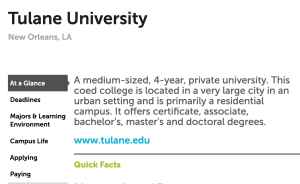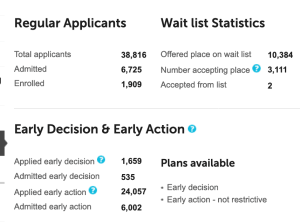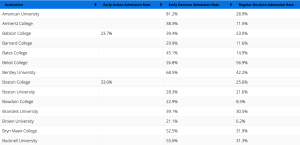
High school seniors, who are aiming for prestigious colleges and universities, will soon have to decide if they will apply early decision.
When students apply early decision, they promise that they will attend if the institution accepts them. A student accepted via early decision must withdraw all other college applications.
Early Decision Gamble
Students must make this ED commitment before they know what kind of financial aid or merit awards the school might provide.
Because students are supposed to commit without this essential financial information, the ED route benefits wealthy families who can pay regardless of whether or not they are happy with the award package.
Early Decision Advantage
Teenagers do enjoy a significant admission advantage at many schools that offer early decision. You can discover if there is an early decision or early action advantage at a particular institution by heading to the College Board’s website.
I’m using Tulane University to illustrate what you’ll discover.
Step One
Type in the name of the institution in the College Board’s search box.
Step Two
Click on the school’s Applying link in the left-hand column.

Step 3
At the top of the Applying page, you’ll see the acceptance statistics for regular decision, early action and early decision applicants. You’ll also see the wait list stats.
The most recent acceptance rate for all applications at Tulane was 17%. In contrast, the ED acceptance rate was 32%. At some schools, an even greater divergence in the rates exists.
The College Board provides a school’s overall acceptance rate, but you’ll have to do the math to generate the the ED and Early Action acceptance rates.

Another Early Decision Resource
Rather than researching schools individually, you can head to College Transitions, a college consulting firm in Georgia, which compiles these admission figures for you.
You’ll also find many other key college statistics in the firm’s Dataverse resource section.
Here is a screenshot of College Transitions ED/EA list:

Other things to know about Early Decision
If necessary, you can go for Early Decision more than once.
A growing number of schools offer a second ED round with the application deadline often on January 1.
You could try this route if you didn’t get into your first ED school. It’s also a way to boost your admission chances if you applied Early Action to other schools and aren’t excited about your choices. Or ED II could be a smart option if you need time to make your ED application stronger with first semester senior year grades, test scores and additional accomplishments.
Net price calculators are a must for ED decisions.
If money is an issue, it’s critically important that parents use a school’s net price calculator before allowing their child to apply early decision.
A net price calculator will provide a personal estimate of what a school will cost after any grants and scholarships from the institution itself are deducted from the price tag along with any applicable state and federal grants.
Early Decision Example
To illustrate why the use of a school’s net price calculator is critical, I’m sharing the situation of a mom, who asked me if her son should risk going this route since he would need financial support.
Here was her email:
Have you ever encountered a school that has an early decision program where a student could opt out of an acceptance if the financial award was not enough?
I am wondering about Harvey Mudd College in particular – my son’s number one choice – but our finances are limited. Might they put something in writing to let him apply early decision with an opportunity to review the financial award granted before accepting their offer
Here is what I told the mom:
I would not apply Early Decision to Harvey Mudd (an excellent engineering/liberal arts college), or any other school, if the institution’s net price calculator suggests that the cost will be prohibitive. In the past, it was a crapshoot to apply ED because of the unresolved money issue, but now many schools offer very good net price calculators that provide a family with a solid estimate of what an institution will cost them.
I told the mom that it was quite likely that this elite college would come through with an excellent financial aid package. Harvey Mudd is one of a few dozen schools in the nation that meet 100% of a student’s demonstrated financial need.
For families who need a great deal of financial assistance, I don’t think it’s a risk to apply to elite schools that offer excellent financial aid packages. If a college has pledged to meet 100% of the demonstrated financial need of all its students — or very close to that — I believe it’s safe to apply.
And sure enough, when the mom used Harvey Mudd’s net price calculator, it estimated that the price would be just $15,000 for her son’s freshman year. The cost of attendance at this prestigious school, which is located in Claremont, CA, is more than $70,000. Attending Harvey Mudd at this price would be a tremendous bargain.
Without using a net price calculator, many families would never even consider applying to such an expensive school.
Here is one more consideration: The acceptance rates for ED and regular decision at Harvey Mudd are almost identical (16.1% v. 15.3%) so applying early won’t provide an admission advantage.
I wanted to share an email from a mom who wondered if her son should risk going the ED route since he will need financial support. Here is an excerpt:
Have you ever encountered a school that has an early decision program where a student could opt out of an acceptance if the financial award was not enough?
I am wondering about Harvey Mudd College in particular – my son’s number one choice – but our finances are limited. Might they put something in writing to let him apply early decision with an opportunity to review the financial award granted before accepting their offer.
Here is what I told the mom:
I would not apply Early Decision to Harvey Mudd (an excellent engineering/liberal arts college), or any other school, if the institution’s net price calculator suggests that the cost will be prohibitive.
In the past, it was a crap shoot to apply ED because of the unresolved money issue, but now many elite schools offer very good net price calculators that provide a family with a solid estimate of what an institution will cost them.
Net Price Calculator Background
For those who don’t know what a net price calculator is, here’s a quick description:
A net price calculator will provide a personal estimate of what a school will cost after any grants and scholarships from the institution itself are deducted from the price tag along with any applicable state and federal grants.
To arrive at a net price, a good calculator will require parents to provide parent and student income and assets. If a school offers merit scholarships, in addition to need-based aid, it will also require a student’s GPA and test scores.
Unfortunately, about half of the nation’s colleges and universities use lousy calculators that are just about useless. These pathetic calculators use a federal template that ask the users few questions. It’s a good bet that the calculator is a poor one if it takes about a minute or less to use.
If a school’s calculator is a poor one, applying early decision will be a much more difficult decision.
ED and Harvey Mudd
I told the mom who asked about Harvey Mudd that it was quite likely that this elite college would come through with an excellent financial aid package since this is one of a few dozen schools in the nation that meet 100% of a student’s demonstrated financial need.
I don’t think it’s much of a risk to apply ED to elite schools that offer excellent financial aid packages. If a college has pledged to meet 100% of the demonstrated financial need of all its students, I believe it will usually be safe to apply.
And sure enough, when the mom used Harvey Mudd’s solid calculator, it estimated that the price would be just $15,000 for her son’s freshman year. The cost of attendance of this school, which is located in Claremont, CA, is $77,000! Attending Harvey Mudd at this price would be a tremendous bargain.
Without using a net price calculator, many families would never even consider applying to such an expensive school.
Walking Away from an ED Acceptance
What if a child applies early decision and gets a lousy financial aid package?
As a practical matter, no school can force a child to attend. If the financial aid isn’t adequate you should talk to the school to seek more assistance and if that doesn’t work you can walk away.
